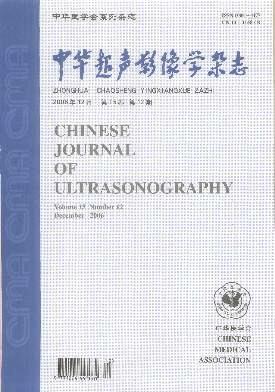Application of transesophageal echocardiography in high ventricular septal defect closure via the small intercostal incision with eccentric occluder in children
Q4 Medicine
引用次数: 1
Abstract
Objective To explore the value of transesophageal echocardiography (TEE) in high ventricular septal defect (VSD) occlusion via a left parasternal ultra-minimal intercostal incision (≤1 cm) with eccentric occluder in children. Methods Forty-eight children with high VSD underwent device occlusion via ultraminimal intercostal incision with eccentric occluder. The whole operation, including preoperative evaluation, intraoperative localization and guidance and postoperation evaluation were performed under the guidance of TEE. Results Forty-six children with high VSD underwent successfully device closure in all 48 cases and the operation success rate was 95.8%. The average size of high VSD was 2.2-6.0 (3.70±0.90)mm and the average size of eccentric occluder was 4-8 (5.48±1.12)mm. The average operation duration was 18-98 (49.80±16.71)min. There were 2 cases of peri-membranous high VSD and 44 cases of outlet-typle VSD, of which 10 cases of mild aortic valve prolapses (AVOP), including 5 cases of aortic valve regurgitation(AR). In addition, there was 1 case of replacement of device, 1 case of having septum below the margin of the defect and 1 case of using a dilator for a small defect. The 46 cases were followed up for 6 to 42 months, and the pericardial effusion occured in 3 cases and disappeared during follow-up. No other abnormal conditions were found. Conclusions During the surgery of high VSD device occlusion via ultraminimal intercostal incision with eccentric occluder, TEE has an important value in defect assessment, intraoperative localization and guidance, and immediate evaluation of efficacy, and can effectively guide the device occlusion of high VSD. Key words: Echocardiography, transesophageal; Ventricular septal defect; Minimal surgical procedures; Children经食管超声心动图在儿童偏心闭塞小肋间切口高室间隔缺损闭合中的应用
目的探讨经食管超声心动图(TEE)在小儿高室间隔缺损(VSD)经左胸骨旁超小肋间切口(≤1cm)偏心闭塞术中的应用价值。方法对48例高室间隔缺损患儿采用偏心闭塞器经肋间小切口闭塞。整个手术在TEE的指导下进行,包括术前评价、术中定位指导及术后评价。结果48例高VSD患儿46例均成功闭合,手术成功率为95.8%。高VSD平均大小为2.2 ~ 6.0(3.70±0.90)mm,偏心闭塞平均大小为4 ~ 8(5.48±1.12)mm。平均手术时间18 ~ 98(49.80±16.71)min。膜周高VSD 2例,出口型VSD 44例,其中轻度主动脉瓣脱垂(AVOP) 10例,其中主动脉瓣反流(AR) 5例。此外,有1例更换装置,1例在缺损边缘以下有隔膜,1例使用扩张器治疗小缺损。46例患者随访6 ~ 42个月,3例出现心包积液,随访中消失。未发现其他异常情况。结论在偏心闭塞器超小肋间切口高位VSD闭塞术中,TEE在缺损评估、术中定位指导、即刻疗效评价等方面具有重要价值,可有效指导高位VSD闭塞术。关键词:超声心动图;经食管;室间隔缺损;最少的外科手术;孩子们
本文章由计算机程序翻译,如有差异,请以英文原文为准。
求助全文
约1分钟内获得全文
求助全文
来源期刊

中华超声影像学杂志
Medicine-Radiology, Nuclear Medicine and Imaging
CiteScore
0.80
自引率
0.00%
发文量
9126
期刊介绍:
 求助内容:
求助内容: 应助结果提醒方式:
应助结果提醒方式:


